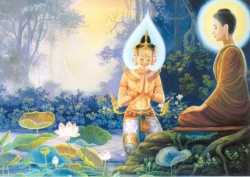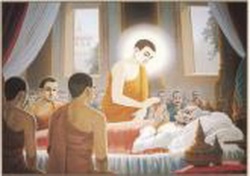Buddhism in Jaffna peninsula
Buddhism in Jaffna peninsula as was practised previously in the Jaffna peninsula in Sri Lanka is demonstrated by archeological sites and literary evidence. In the 20th century most residents are Hindus and there are minorities of Christian, Islamic and Buddhist faiths present.
Nāka Tivu or Nāka Nadu was the name of the whole Jaffna peninsula in some historical documents. There are number of Buddhist myths associated with the interactions of people of this historical place with Buddha.
The two Tamil Buddhist epics of Kundalakesi and Manimekalai describe the islet of Manipallavam of Nāka Tivu/Nadu which is identified with the Nainativu islet of the Jaffna peninsula. This Tamil Buddhist shrine was located close to the ancient Nagapooshani Amman temple of Nainativu, one of the Shakti Peethas.
The famous Vallipuram Buddha statue built with Dravidian sculptural traditions from Amaravati, Andhra Pradesh (Amaravati school) was found in excavations below the Hindu Temple.
The language of the inscription is Tamil-Prakrit, which shares several similarities with script inscriptions used in Andhra at the time, when the Telugu Satavahana dynasty was at the height of its power and its 17th monarch Hāla (20-24 AD) married a princess from the island.
Professor Peter Schalk (University of Uppsala), writes "Vallipuram has very rich archaeological remains that point at an early settlement.
It was probably an emporium in the first centuries AD. […] From already dated stones with which we compare this Vallipuram statue, we can conclude that it falls in the period 3-4 century AD.
During that period, the typical Amaravati-Buddha sculpture was developed." The Buddha statue found here was gifted to King of Thailand by the then British Governor Henry Blake in 1906.
Dr. Indrapala, Senior Lecturer in History at the Peradeniya Campus argued for a flourishing pre-Christian buddhist civilization in Jaffna, in agreement with Paranavithana, and Mudliyar C. Rasanayakam, Ancient Jaffna in an earlier work, 1965.
This place is similar to Nagapatnam where all Asian vessels used it as a stopover point and the Buddhist and Hindu Dagobas are just a resting and worshipping places for the sailors and international traders. Both Nagapatnam and Vallipuram served the powerful kingdoms of China, Siam, Cambodia, Champa (Vietnam) and Java. Kandarodai
A group of dagobas in Kandarodai situated with in close proximity of each other at the site served as a monastery for Tamil monks and reflect the rise in popularity of Mahayana Buddhism amongst Jaffna Tamils and the Tamils of the ancient Tamil country in the first few centuries of the common era before the revivalism of Hinduism amongst the population.

